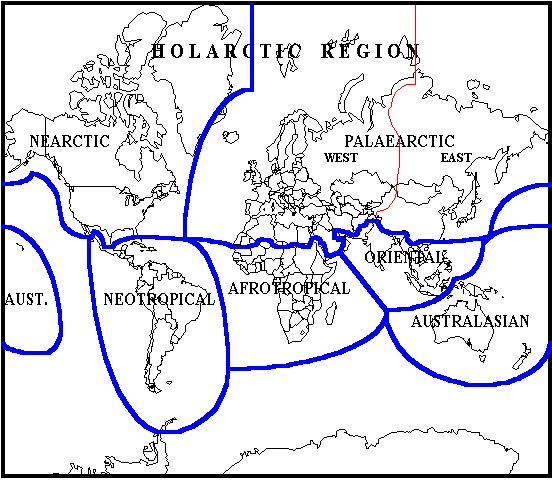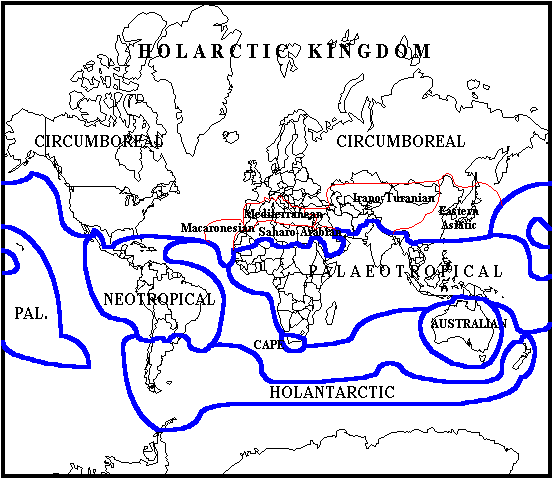This work is a detailed study of the 88 species and subspecies of Sphingidae that occur regularly within the boundaries of the western Palaearctic region, with particular emphasis on their ecology, biology and biogeography. It's main aims are to collate and review in a scientific manner the information already published; to update that information; to identify gaps in the knowledge and to try to fill them, or at least allow others to do so; to analyse the data in order to provide new information on ecology, biology and biogeography; and to resolve a number of confused and confusing taxonomic problems. Its most important function is to provide a firm foundation for the understanding of the dynamic biogeography (Hengeveld, 1990) of the Sphingidae of the western Palaearctic and hence of the dynamic nature of biogeography in general.
Although the hawkmoths were first formally classified by Carl von Linne (Linnaeus) in 1758 under the name Sphinx, it was not until 1903 that a complete revision of the 722 species of this family then recognized was published by Rothschild & Jordan. By 1911 some 850 species were known. As with most insects, the sphingids reach their greatest diversity in the tropics. The number of species and genera diminishes with increasing latitude and none is resident in the Arctic and Antarctic regions. With the exception of these regions, the family is found throughout the world, even on small oceanic islands. Today there are approximately 1600 known species, of which 100 are resident in the Palaearctic and approximately 59 in the western portion of this biogeographical area.
Map 1: The main zoogeographical regions of the world, with the western palaearctic defined.

The western boundary of the western Palaearctic covered by this work is 40 degrees W (mid-Atlantic), and includes the Azores. The southern boundary runs approximately along 20 degrees N (the southern boundary of the Saharo-Arabian floristic region (Takhtajan, 1986)). The northern limit is 80 degrees N (the Arctic Ocean) and the eastern limit approximately 90 degrees E as far south as the Altai Mountain range (see Map 1). The Russians regard the Yenisey River to be the natural boundary between the eastern and western halves of the Palaearctic region, which approximates to 90 degrees E. De Lattin (1967) agrees with this and accepts the Johannsen line, which follows the Yenisey River except in the far north, where it veers off to 100 degrees E. From the Altai the boundary is less distinct, running south-westwards through the Tian Shan, Pamir, Hindu Kush (de Lattin, 1967) and along the south-eastern edge of the Iran-Afghanistan plateau and thence across the Gulf of Oman to Muscat. The fauna and flora within this natural region forms a recognizable, distinct community governed by distinct climatic parameters (de Lattin, 1967; Takhtajan, 1986).
Map 2: Floristic kingdoms of the world (after Takhtajan, 1986; Moore, 1991).

The definition in this work of what constitutes the western Palaearctic thus differs somewhat from that in most other works, which have tended to select easily identifiable features such as mountain chains or rivers as boundaries. Europe is a geopolitical entity and of little significance to sphingid ecology. The western Palaearctic, on the other hand, is a distinct biogeographical region with, for the most part, clearly defined boundaries. To the west it is cut off from North America by the vast expanse of the Atlantic Ocean. To the south the hot and dry Sahara desert forms a very effective barrier to all but the most determined Afrotropical species, although several have been recorded from the Hoggar Mountains of southern Algeria (Eitschberger, Mooser & Müller, 2014). To the north lie the frozen Arctic wastes, and to the east the vast inhospitable swamps and boreal forests of central Siberia. (The Urals are regarded by many as the natural eastern boundary of the western Palaearctic, but these low mountains do not, in fact, form a very effective barrier). Only to the south-east does the flora and fauna merge with that of the Oriental region along a mountainous boundary which stretches from Afghanistan and Kashmir down through western Pakistan to Baluchistan.
This work covers those sphingids which are resident within the above-mentioned boundaries of the western Palaearctic. It also covers those species which are regular migrants into this area from the Afrotropical region. Where relict populations of species or genera which are obviously of western Palaearctic origin are present outside the region, such as on the Cape Verde Islands and in south-western Saudi Arabia and Yemen, these also have been included. It does not cover what are clearly Oriental species which penetrate into the warmer areas of Kashmir and Afghanistan; these are listed under vagrants. The mixed fauna of Pakistan is also excluded except for clearly recognizable Palaearctic species whose distribution extends into the cool western and northern highlands of that country.
 Return to species list
Return to species list